How to protect yourself from malicious websites and programs
What for: To protect the browser from threats.
Microsoft Edge has built-in protection against potentially unsafe apps, add-ons and websites. If a file or a Web recourse seems suspicious, the browser may block it from loading. To activate this protection:
- Click the three dots in the upper right corner of the screen;
- Select Settings;
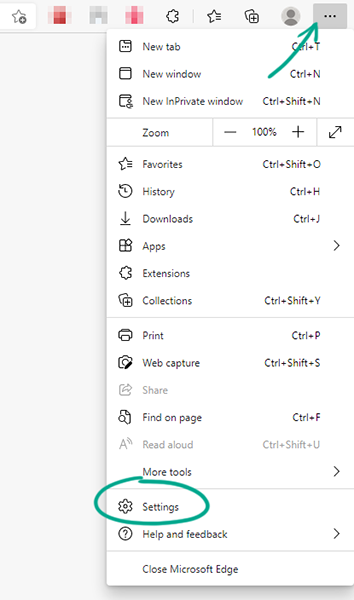
- Go to the Privacy, search, and services section in the menu on the left;
- Scroll down to the Security section and enable these options:
- Microsoft Defender SmartScreen;
- Block potentially unwanted apps.

What for: To prevent attackers from redirecting you to a malicious website.
To load a website, browsers use its IP address — a group of digits separated with dots, such as 172.217.18.100. These are not easy to remember the way they are, so browsers use the Domain Name System (DNS). This allows to identify website IP addresses by their alphabetic names. So instead of 172.217.18.100, you can type google.com and end up on the same page. When you type a website name, the browser sends a DNS request to a special server, which in turn sends back the corresponding IP address.
However, if attackers intercept such a request and respond to your browser by sending a different IP address, you'll end up on a wrong website. This way, cybercriminals can redirect victims to a fake sign up or payment page and steal their passwords or bank card info. Microsoft Edge can use DNS servers that encrypt their traffic to stop attackers from intercepting data. To activate this feature:
- Click the three dots in the upper right corner of the screen;
- Select Settings;
- Go to the Privacy, search, and services section in the menu on the left;
- In the Security section, enable Use secure DNS to specify how to lookup the network address for websites;

- If the default DNS provider does not support secure DNS, choose a different one. Select Choose a service provider and click the input field to view the list of available options.
What for: To keep website owners from knowing too much about you.
When you visit a website, your device stores a cookie file — a small fragment of data with information about your system and actions on the website. Developers use it to identify visitors and offer personalized ads. You can limit the use of cookies in your browser settings.
- Click the three dots in the upper right corner of the screen;
- Select Settings;
- Go to the Cookies and site permissions section on the left;
- Click Manage and delete cookies and site data;

- Select how cookies should be treated by the browser:
- Allow sites to save and read cookie data — websites will use cookies without any limitations. Turn off this option if you want to block cookies completely.
- Block third-party cookies — stops websites from saving cookies for other companies. These are normally placed by advertisers to show target ads. Unlike basic cookies, they can be used to collect information from several websites at once. If you enable this option, websites will continue to store data about you in cookies, but each developer will only know about your actions at their website.
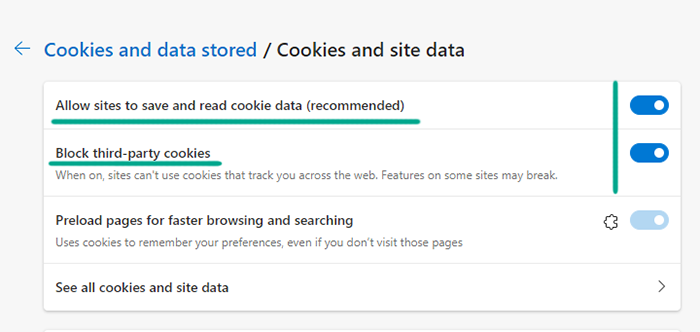
You can configure cookie rules for individual websites. Click Add next to the Allow or Block list and enter the website address. You can also add any website to the list of Web resources whose cookies should be cleared when you close the browser.
Downside: Having to manually enter your credentials and configure settings each time you visit a website.
What for: To stop websites from accessing your computer and browser capabilities.
Websites can request your permission to access various computer and browser capabilities, such as microphone, camera, location and notifications. Such access may help to improve website performance — for example, online stores may present special offers they have in your city and hide irrelevant ones. However, attackers may use these permissions to spy upon you. Check your list of permissions and revoke unnecessary ones from suspicious websites.
- Click the three dots in the upper right corner of the screen;
- Select Settings;
- Go to the Cookies and site permissions section on the left;
- In the All permissions list, select each permission one by one and turn them off altogether or remove unwanted websites from the Allow section.

What for: To protect against vulnerabilities.
JavaScript is used to display interactive objects and animations, such as buttons and drop-down menus, on websites. Even though built into nearly all Web pages, this programming language contains plenty of well-known vulnerabilities. These are often abused by cybercriminals to steal personal data and infect computers with malware. Disable JavaScript to eliminate the risk.
- Click the three dots in the upper right corner of the screen;
- Select Settings;
- Go to the Cookies and site permissions section on the left;
- In the All permissions list, select JavaScript and disable it.

Downside: Some website features will become unavailable, and some pages may work incorrectly.
How to hide your data from prying eyes
What for: To leave no tracks.
By default, Microsoft Edge saves a list of pages you visit, files you download, and other information. It helps you find the websites you need and use them comfortably. However, if you share your computer, important personal info may be revealed to others. To avoid this, use the private browsing mode. The browser will delete all browsing data from private windows and tabs when you close them, but it won't affect browsing history and website data logging in general.
To activate the private mode:
- Click the three dots in the upper right corner of the screen;
- Select New InPrivate window.

What for: To keep people from seeing the pages you've visited.
When you start Edge, it can open the last page you've visited. People that happen to be nearby may see the websites you've visited. To hide this data, set your home page to a new tab or a specific website.
- Click the three dots in the upper right corner of the screen;
- Select Settings;
- Go to the Start, home and new tabs section in the menu on the left;
- Check Open the new tab page or Open these pages and select the websites the browser will open when it starts;

- By default, new tabs show your most visited websites. To hide them from others, open a new tab and click the gear icon in the upper right corner of the screen;
- Select Custom in the Page layout section;
- Turn off the Quick links.

Downside: You will have to open the websites you were visiting before closing the browser manually if you want to go on using them.
What for: To leave no traces of your activity.
If you use Microsoft Edge on someone else's computer or share your device, other people may see your browsing history, downloaded files, passwords, and other confidential info. To keep those secret, clear your browsing data on closing the browser.
- Click the three dots in the upper right corner of the screen;
- Select Settings;
- Go to the Privacy, search, and services section in the menu on the left;
- Scroll down to Clear browsing data and click Choose what to clear every time you close the browser;

- Choose the data to be cleared on exit.
Downside: You'll have to type your passwords and other website data all over again each time.
What for: To keep other people from seeing pages from your history and favorites.
As you begin typing a search query or URL, the browser may suggest suitable websites from your history or list of favorites. It is convenient, but if there are other people around, they might also see the suggestion. To hide this data, turn off search and site suggestions.
- Click the three dots in the upper right corner of the screen;
- Select Settings;
- Go to the Privacy, search, and services section in the menu on the left;
- Scroll down and select Address bar and search;

- Turn off Show me search and site suggestions using my typed characters and Show me suggestions from history, favorites and other data on this device using my typed characters.

Downside: To find the page you need, you will have to type the query or website address in full.
How to keep corporations out of your business
What for: To keep notifications from distracting you and to save computer resources.
By default, some Microsoft Edge services are allowed to operate in the background. For example, social network notifications will continue to appear even when you close your browser. Yet some services may misuse this function to spy on you or send spam. Besides, this draws on computer resources. To turn off background services:
- Click the three dots in the upper right corner of the screen;
- Select Settings;
- Go to the System section in the menu on the left;
- Turn off Continue running background extensions and apps when Microsoft Edge is closed.
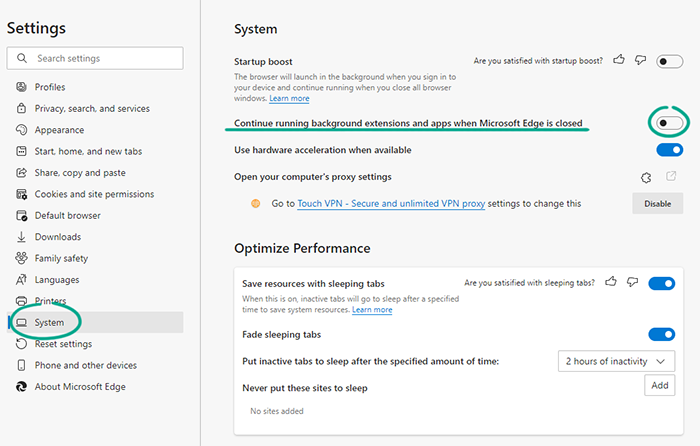
Downside: You'll stop getting notifications after closing the browser.
What for: To set the privacy and security level that suits you.
By default, Microsoft Edge protects your privacy when browsing and blocks trackers that collect information about your Internet activities, interests and preferences. In addition, Microsoft Edge protects you against malicious scripts such as cryptominers, which secretly draw on your device resources. To configure tracking prevention:
- Click the three dots in the upper right corner of the screen;
- Select Settings;
- Go to the Privacy, search, and services section in the menu on the left;
- Under Tracking prevention, select the level that suits you:
- Basic. Microsoft Edge will block some tracking tools and terminate the known dangerous scripts.
- Balanced. Microsoft Edge will block tracking tools of advertising networks and terminate dangerous scripts.
- Strict. Microsoft Edge will block all tracking tools and terminate dangerous scripts.
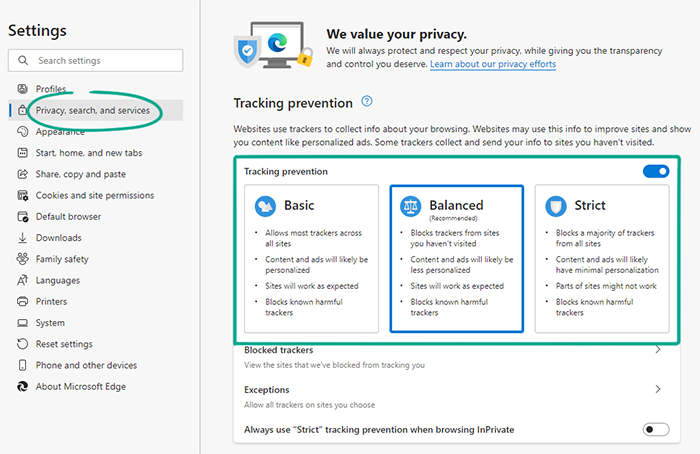
Downside: If you select the strict tracking prevention level, some websites may work incorrectly.
What for: To notify website owners you do not want to provide information about your activities.
Most websites collect information about their visitors' actions. Such data can be used to personalize ads or passed on to third parties. If you don't want websites to track your activities, you may notify website owners about it.
- Click the three dots in the upper right corner of the screen;
- Select Settings;
- Go to the Privacy, search, and services section in the menu on the left;
- Under Privacy, enable Send "Do Not Track" requests.

Bear in mind: this notification doesn't enforce any requirement to stop tracking.
What for: To stop developers from gathering extra information about your activity.
Microsoft Edge automatically collects its diagnostic data. The developers declare they use such data to add new features and fix bugs. You cannot opt out of this completely — the browser will report the basic set of data about your device and settings in any case. But you can prevent it from sending Microsoft extra data about your browsing, such as website addresses and page content.
- Click the three dots in the upper right corner of the screen;
- Select Settings;
- Go to the Privacy, search, and services section in the menu on the left;
- In the Optional diagnostic data section, click Windows diagnostic data setting;
- If a window pops up prompting for permission to enter settings, click Open;

- Select Required diagnostic data.
What for: To keep Microsoft from learning which websites you visit.
Microsoft Edge can use the browsing history data for content personalization. For example, if you've searched the Internet for sports news, your home page may feature sports articles, and website banners may advertise sports equipment or sports tickets. To make this possible, Edge sends Microsoft the addresses of all the pages you have viewed. If you don't want to share this information with developers, disable log-based personalization.
- Click the three dots in the upper right corner of the screen;
- Select Settings;
- Go to the Privacy, search, and services section in the menu on the left;
- Scroll down to the Personalize your web experience section and revoke the permission to use your browsing history.

After doing this, you will continue to see ads, but they will not be based on your personal data.
What for: To keep search giants from gathering information about you.
Many search engines, such as Google or Bing, save search queries and user data. This allows these companies to show customized search results and promote their services. However, there are services that do not collect any such data, e.g. DuckDuckGo. If you prefer to stay anonymous, you can assign this service as the default search engine.
- Click the three dots in the upper right corner of the screen;
- Select Settings;
- Go to the Privacy, search, and services section in the menu on the left;
- Scroll down and select Address bar and search;

- Choose the search engine you want from the Search engine used in the address bar list;

- If it's not on the list, add it manually. Select Manage search engines at the bottom of the page;
- Click Add;

- Fill in the search engine name and keyword. You may type any name and keyword, for example, DuckDuckGo;
- Fill in the URL, using %s in place of query:
- In a new tab, open the search engine you want as default, such as https://duckduckgo.com/;
- Copy its URL from the address bar and paste it in the URL field;
- Add ?q=%s to the end of the URL. The link should look like this: https://duckduckgo.com/?q=%s;
- Click the Add button.
How to protect your data
What for: To keep your contact data private.
If you type your contact data, such as address of phone number, on any website, Microsoft Edge will prompt you to save it. If you agree, the browser will fill it in whenever you complete forms on other websites. It is convenient, yet if someone gains access to your computer, they will learn your personal information. To delete your information:
- Click the three dots in the upper right corner of the screen;
- Select Settings;
- Go to the Profiles section on the left;
- Select Personal info;

- Turn off Save and fill personal info;

- In the Personal info list, click the three dots next to the saved data you want to delete and select Delete.
Downside: You will have to enter your address and other contact details manually.
What for: So nobody can gain access to your accounts.
Microsoft Edge can save passwords you use to sign in to websites and fill them in automatically when you return, so you won't have to remember them. It is convenient, yet if someone gains access to your computer, they'll be able to sign in to these accounts, too. To prevent this, disable saving passwords:
- Click the three dots in the upper right corner of the screen;
- Select Settings;
- Go to the Profiles section on the left;
- Click Password;
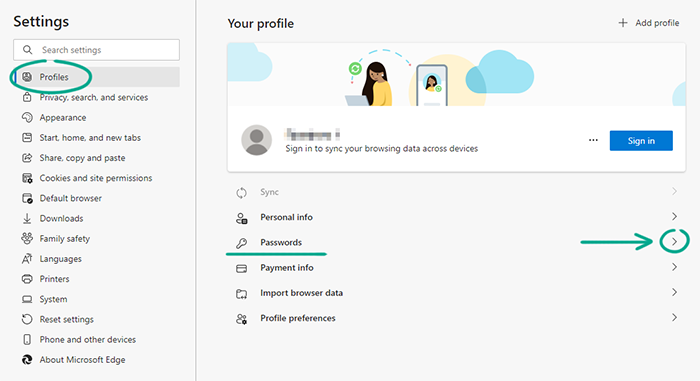
- Turn off Offer to save passwords and Show the "Reveal password" button in password fields;
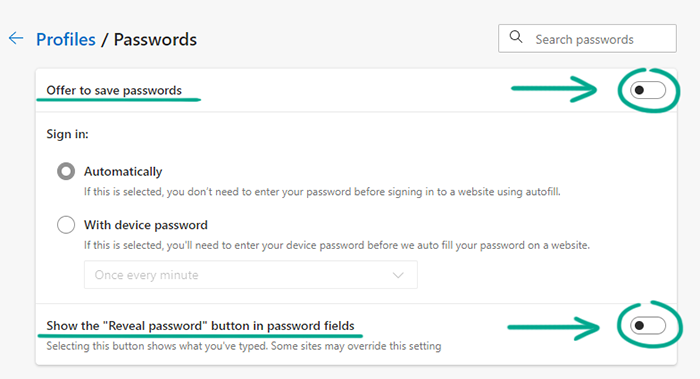
- To delete stored data, in the Saved passwords list click the three dots to the right of the website name and select Delete.
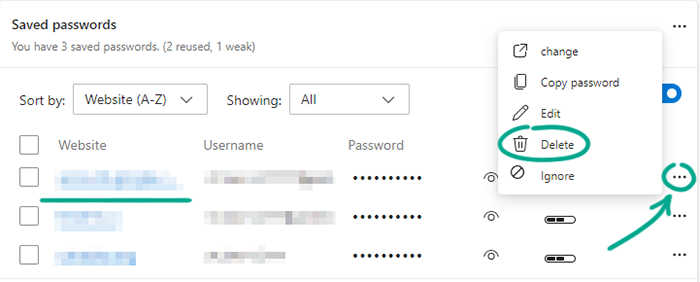
Downside: You'll have to enter logins and passwords every time you sign in.
You can avoid the inconvenience and improve the security of your accounts using a password manager. Unlike a browser, it does not access third-party resources on the Web, which means it is protected from malicious websites. Neither can it be hacked via a vulnerable extension or plug-in.
What for: To avoid accidental purchases and protect against payment info theft.
Microsoft Edge can store bank cars details when you enter them to buy something on the Internet and fill them in automatically for further purchases, so you won't have to re-enter them. Yet if someone else gets access to your computer, they'll be able to make a payment using your card. Besides, despite all the security measures, payment details stored in your browser are at risk of theft. To delete your payment details:
- Click the three dots in the upper right corner of the screen;
- Select Settings;
- Go to the Profiles section on the left;
- Click Payment info;
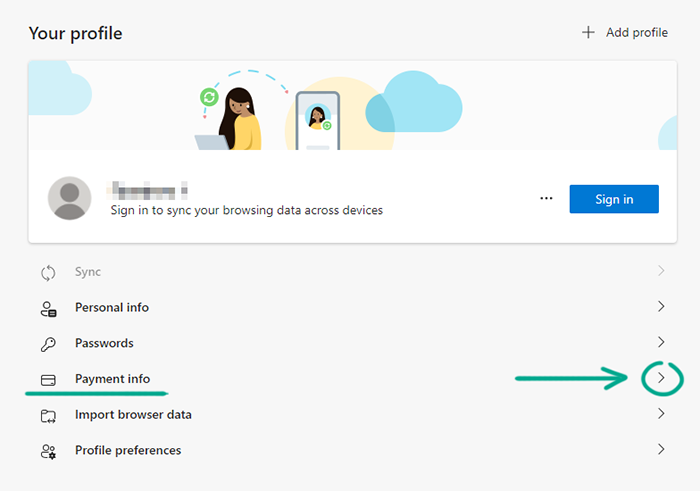
- Turn off Save and fill payment info;

- In the Cards you've saved on this device list, click the three dots next to each card and select Delete.
Downside: You'll have to manually enter your card details every time you buy something.







